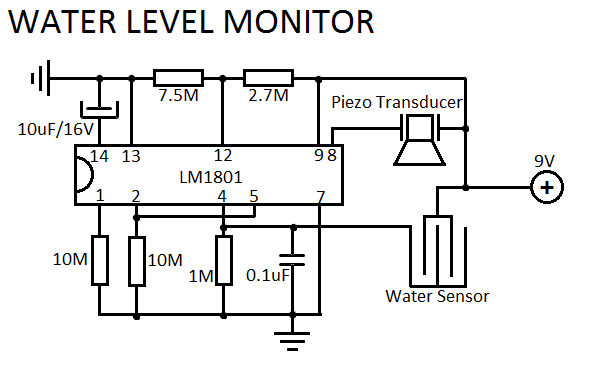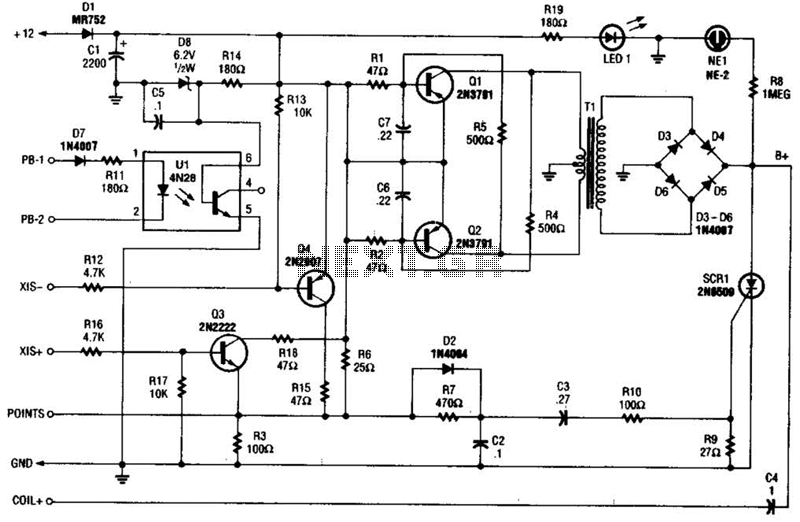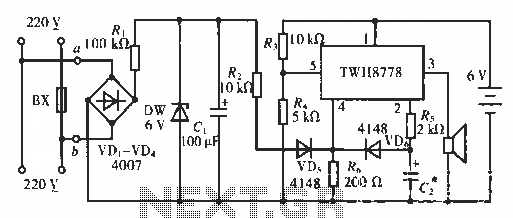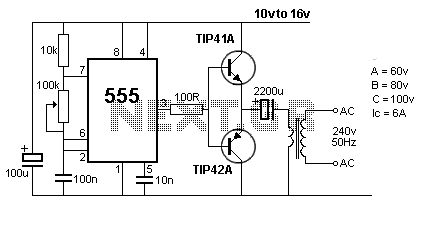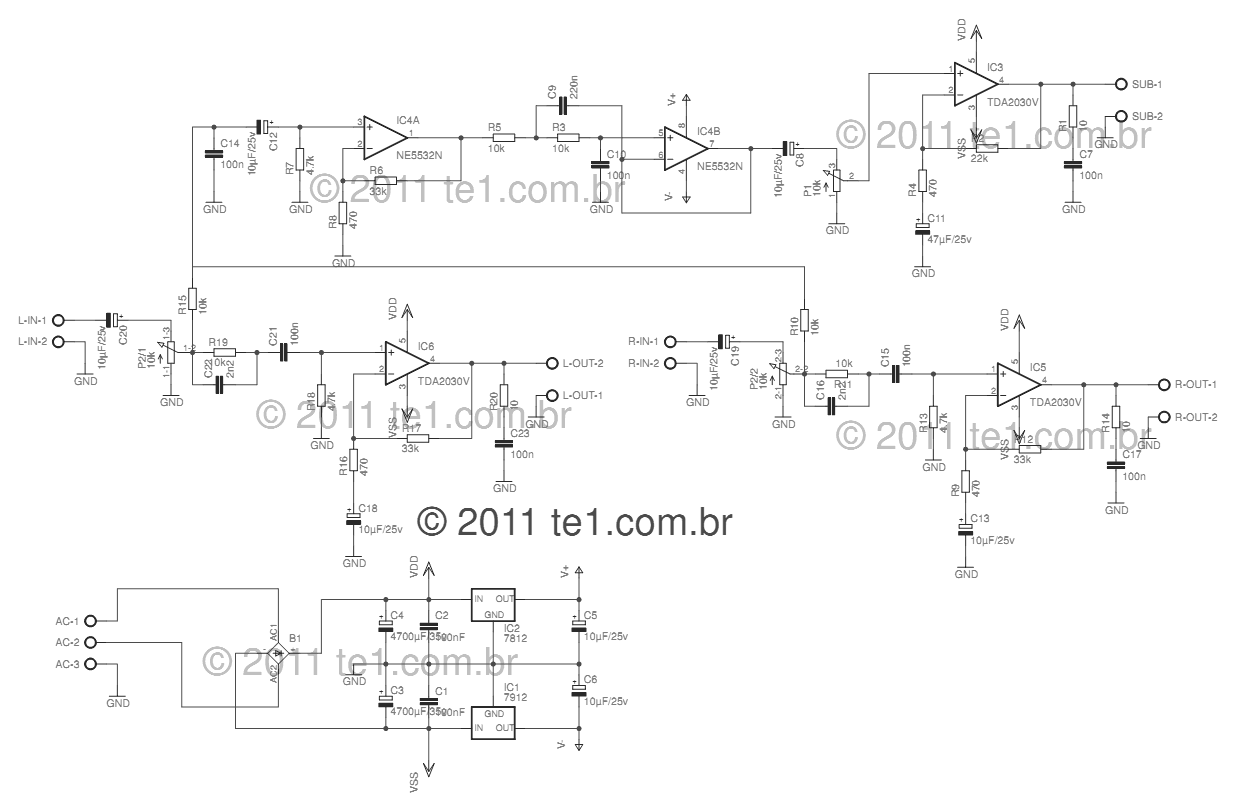
MC2833 FM transmitter circuit design electronic project

A simple FM transmitter circuit can be designed using the MC2833 integrated circuit, which is intended for cordless telephone and FM communication applications. This circuit includes a microphone amplifier, a voltage-controlled oscillator, and two auxiliary transistors. The final output frequency is produced through frequency multiplication within the MC2833 IC. The RF output buffer (Pin 14) and Q2 transistor function as a frequency tripler and doubler, respectively, for the 76 MHz and 144 MHz transmitters. The power output is 9 + 10 dBm for the 50 MHz and 76 MHz transmitters, and 9 + 5 dBm for the 144 MHz transmitter when VCC is set to 8.0 V. The power output decreases with lower VCC values.
The FM transmitter circuit utilizing the MC2833 IC is designed for efficient operation in cordless telephony and FM communication systems. The architecture of this circuit comprises several key components that work in unison to generate a stable FM signal. The microphone amplifier captures audio signals and amplifies them for further processing. This amplified signal is fed into a voltage-controlled oscillator (VCO), which modulates the frequency based on the input audio signal.
The MC2833 IC integrates multiple functionalities, including a frequency multiplier that enhances the output frequency to the desired transmission bands. The RF output buffer, located at Pin 14, is crucial for driving the output load and ensuring that the signal is adequately amplified before transmission. The auxiliary transistor Q2 serves a dual purpose, functioning as both a frequency doubler and tripler for different operating frequencies, specifically tailored for 76 MHz and 144 MHz applications.
Power output specifications indicate that the circuit can deliver 9 + 10 dBm for the 50 MHz and 76 MHz transmitters, while the output for the 144 MHz transmitter is slightly lower at 9 + 5 dBm. These values are achieved under optimal conditions with a supply voltage (VCC) of 8.0 V. It is important to note that the power output is inversely related to the supply voltage; as VCC decreases, the overall output power diminishes, which may affect the effective range and clarity of the transmitted signal.
In summary, this FM transmitter circuit designed with the MC2833 IC is a compact and efficient solution for wireless audio transmission, suitable for various applications in the field of communication technology. The careful selection of components and design parameters ensures that the circuit operates effectively within the specified frequency ranges while maintaining a balance between power output and supply voltage.A very simple FM transmitter circuit can be designed using MC2833 integrated circuit, designed for cordless telephone and FM communication equipment. It includes a microphone amplifier, voltage controlled oscillator and two auxiliary transistors. The final output frequency is generated by frequency multiplication within the MC2833 IC. The RF outpu t buffer (Pin 14) and Q2 transistor are used as a frequency tripler and doubler, respectively, in the 76 and 144 MHz transmitters. Power output is 9 + 10 dBm for 50 MHz and 76 MHz transmitters, and 9 + 5. 0 dBm for the 144 MHz transmitter at VCC = 8. 0 V. Power output drops with lower VCC. 🔗 External reference
The FM transmitter circuit utilizing the MC2833 IC is designed for efficient operation in cordless telephony and FM communication systems. The architecture of this circuit comprises several key components that work in unison to generate a stable FM signal. The microphone amplifier captures audio signals and amplifies them for further processing. This amplified signal is fed into a voltage-controlled oscillator (VCO), which modulates the frequency based on the input audio signal.
The MC2833 IC integrates multiple functionalities, including a frequency multiplier that enhances the output frequency to the desired transmission bands. The RF output buffer, located at Pin 14, is crucial for driving the output load and ensuring that the signal is adequately amplified before transmission. The auxiliary transistor Q2 serves a dual purpose, functioning as both a frequency doubler and tripler for different operating frequencies, specifically tailored for 76 MHz and 144 MHz applications.
Power output specifications indicate that the circuit can deliver 9 + 10 dBm for the 50 MHz and 76 MHz transmitters, while the output for the 144 MHz transmitter is slightly lower at 9 + 5 dBm. These values are achieved under optimal conditions with a supply voltage (VCC) of 8.0 V. It is important to note that the power output is inversely related to the supply voltage; as VCC decreases, the overall output power diminishes, which may affect the effective range and clarity of the transmitted signal.
In summary, this FM transmitter circuit designed with the MC2833 IC is a compact and efficient solution for wireless audio transmission, suitable for various applications in the field of communication technology. The careful selection of components and design parameters ensures that the circuit operates effectively within the specified frequency ranges while maintaining a balance between power output and supply voltage.A very simple FM transmitter circuit can be designed using MC2833 integrated circuit, designed for cordless telephone and FM communication equipment. It includes a microphone amplifier, voltage controlled oscillator and two auxiliary transistors. The final output frequency is generated by frequency multiplication within the MC2833 IC. The RF outpu t buffer (Pin 14) and Q2 transistor are used as a frequency tripler and doubler, respectively, in the 76 and 144 MHz transmitters. Power output is 9 + 10 dBm for 50 MHz and 76 MHz transmitters, and 9 + 5. 0 dBm for the 144 MHz transmitter at VCC = 8. 0 V. Power output drops with lower VCC. 🔗 External reference
Warning: include(partials/cookie-banner.php): Failed to open stream: Permission denied in /var/www/html/nextgr/view-circuit.php on line 713
Warning: include(): Failed opening 'partials/cookie-banner.php' for inclusion (include_path='.:/usr/share/php') in /var/www/html/nextgr/view-circuit.php on line 713

